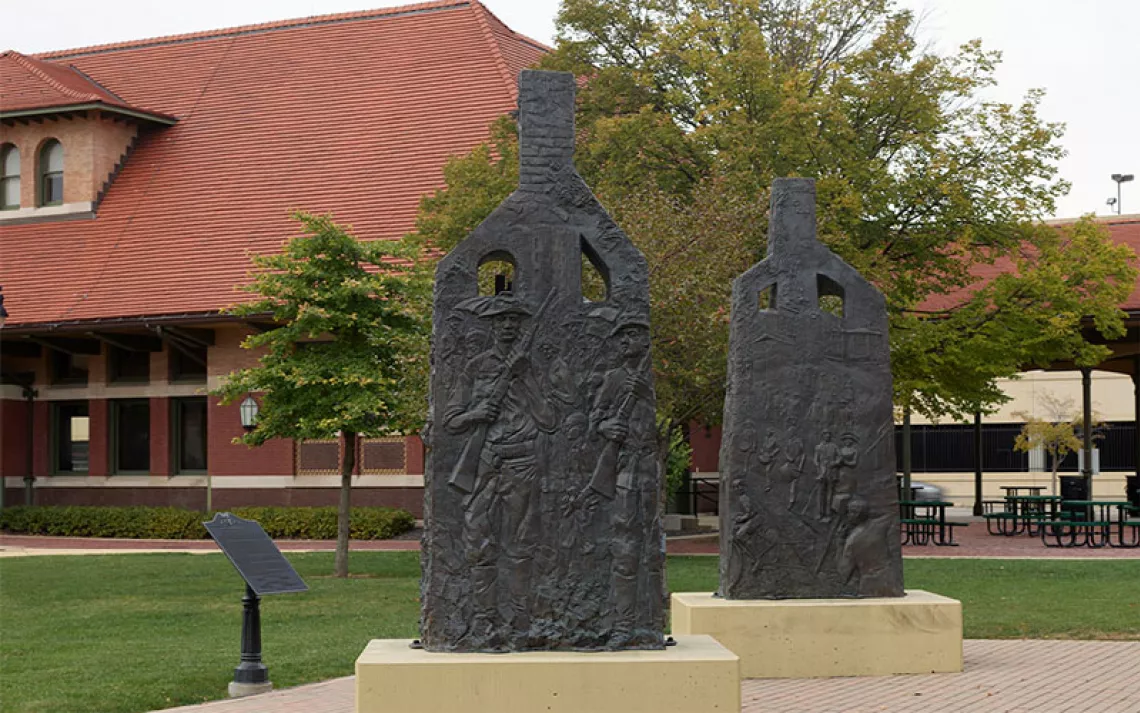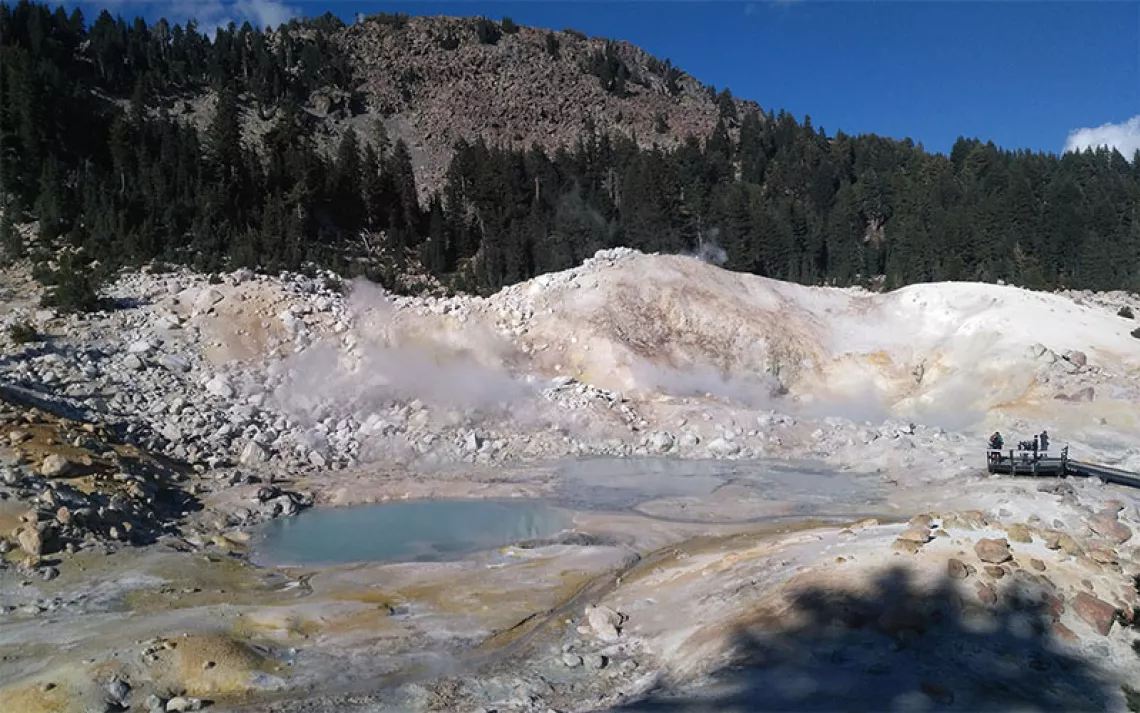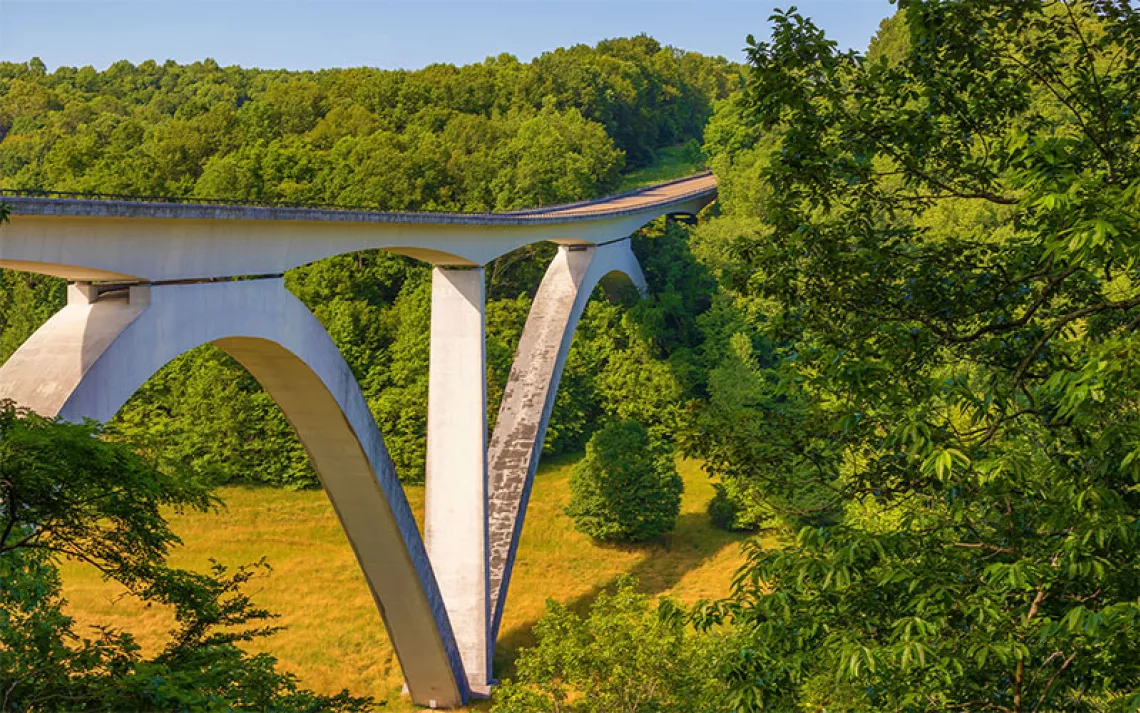Stories to Be Told
Unearthing the Black history in America’s national parks
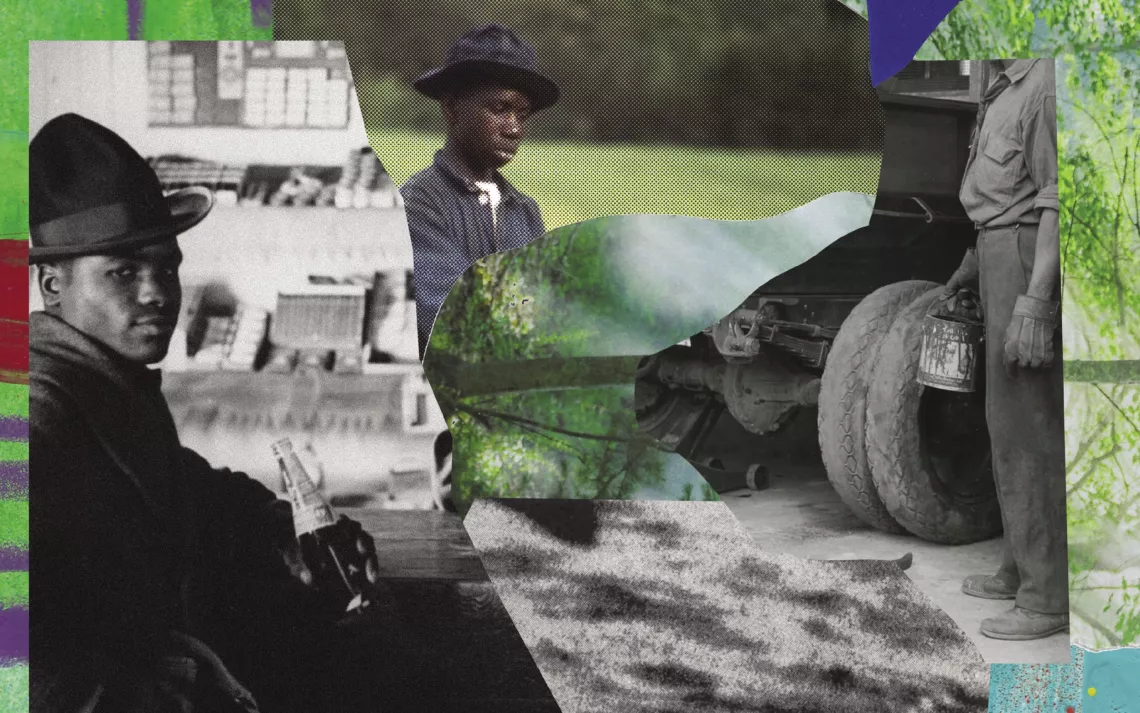
Art by Aaron Marin, a collage artist and illustrator based in upstate New York.
Outside the Oconaluftee Visitor Center in Great Smoky Mountains National Park, the sun is making its way through clouds that promise afternoon rain. It’s late July, and I’m awaiting Antoine Fletcher, the park’s science communicator. For a few years now, his role has included the supervision of an initiative to tell the stories of African Americans who lived in the region, both inside and outside what is now the national park.
The nearly 90-year-old national park, which spans a half million acres across the forested border of Tennessee and North Carolina, is world-famous for its biodiversity research, its archaeological sites featuring remnants from Cherokee and other Native American settlements, and the many homes, churches, and mills of white settlers it has preserved. But until the 2018 advent of the park’s African American Experience Project (subtitled Making the Invisible Visible), Black stories were largely absent from the Smokies’ history.
A trained anthropologist with 15 years’ experience working for the National Park Service, Fletcher, a Black man, arrives in a crisp ranger uniform. He’s quick with jokes about a wave of recent black bear sightings as well as ideas for our three-hour tour through the park’s still-emergent history.
As a diversity, equity, and inclusion consultant and an outdoors enthusiast, I want to make outdoor spaces more equitable so that more people of color can find a sense of belonging in, and thus benefit from, American public lands. (National parks are not known for attracting nonwhite visitors; in 2018, less than 6 percent of park visitors were Black.) Examining the histories of these lands, and looking for the diversity that was once present, might be the best place to start. I want to tell stories that lead to more stories.
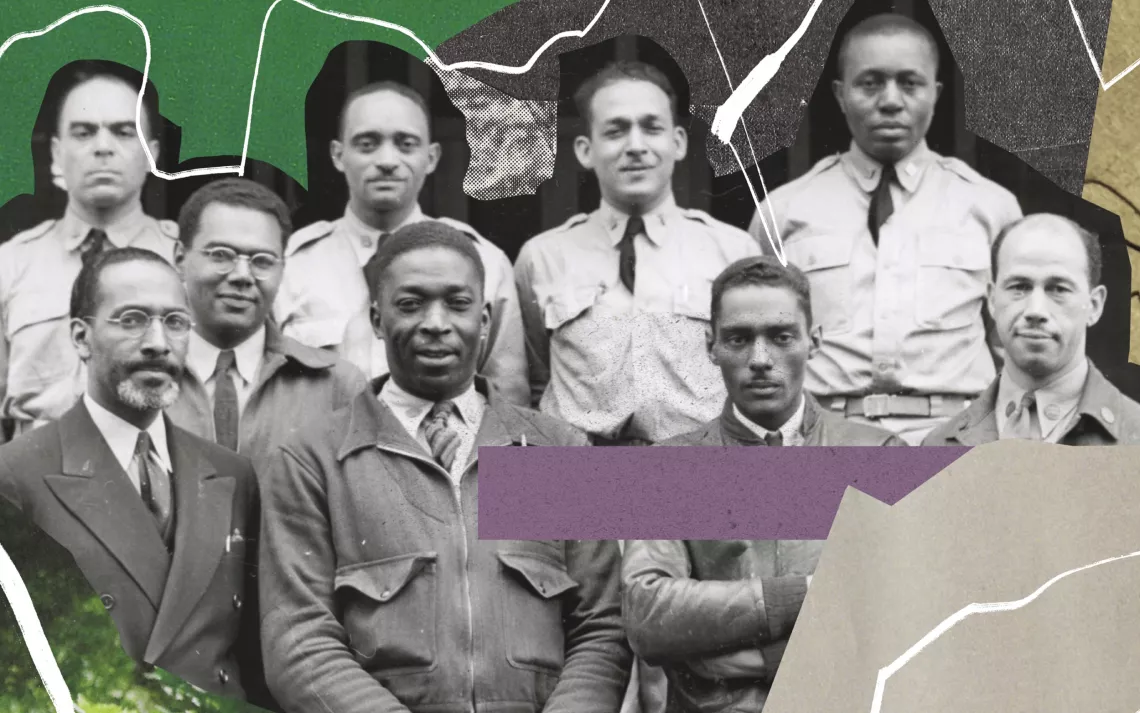
The African American Experience Project is emblematic of the effort to reclaim often-lost history—those stories that may have been long shared by many Black Americans around crackling campfires but have yet to be shared with the world. This NPS-wide initiative has unearthed many stories across the United States, and particularly in the Smokies region of Appalachia, thanks to its robust African American presence.
Most people don’t know about the important roles that Black men have played in Great Smoky Mountains National Park. Much of the park’s infrastructure was built by the Civilian Conservation Corps, a work-relief program that President Franklin Delano Roosevelt created in 1933. But the first Smokies superintendent, J. Ross Eakin, advised against including African Americans in the CCC crews. Records show that Black men helped build the Blue Ridge Parkway outside the park, and they faced tremendous difficulties—for instance, Black workers were not welcome to eat or stay in Gatlinburg, Tennessee, the Smokies’ nearest town, until the 1950s.
In 1964, President Lyndon B. Johnson founded the residential Job Corps program, and the 1960s became a significant decade for Black Americans in the Smokies, many of whom found their careers in the national park. In 1967, the park hired three Black naturalists. That same year, two African Americans enrolled in nearby Haywood Community College’s inaugural forestry program.
Angela Sirna, a lead historian for the National Park Service, says that in addition to Great Smoky Mountains, Acadia National Park, Cumberland Gap National Historical Park, and some other Park Service sites launched integrated Job Corps programs in the 1960s. “Unfortunately, we know very little about the young men who worked in national parks in the first years of [the Job Corps] and their accomplishments,” she says. (Women weren’t allowed to work in the Job Corps centers at national parks.)
I follow Fletcher up a paved road surrounded by a lush green field, pastel mountains visible in the distance, and we begin our tour at the 15-acre Job Corps campus, which sits near North Carolina’s Cherokee Indian Reservation along the banks of the Oconaluftee River. The Job Corps is still in operation as a federally funded educational and vocational training program for 16-to-24-year-olds. At its inception in the early 1960s, the Oconaluftee Job Corps site housed a somewhat revolutionary integrated work program for young Black and white men, managed by the US Forest Service. Despite the South’s abundance of skilled Black laborers, the Job Corps was the first government-sponsored program that allowed Black men to work in the national park.
We find a park bench on the quiet Job Corps campus, in view of old wooden dorms and a gym, and Fletcher opens up his laptop to show me digital records of the first Job Corps men as well as other records he’s amassed of Blacks in the park—laborers who built trails and roads and worked on park maintenance and conservation. “I like to begin with death certificates and work my way back,” Fletcher jokes, explaining that people of the Appalachian Mountains did not generally keep records, preferring to follow an oral tradition. As an immigrant from Somalia, a country that does not maintain medical records or mark birthdays, I can appreciate the challenges Fletcher must face in engaging the Smokies’ communities to access these stories.
Fletcher also spends a lot of time digging through census reports and utilizing Ancestry.com to obtain details about the Blacks who worked, farmed, and lived on the land. He gleans a lot of data from “slave schedules”: lists of the enslavers’ names and how many humans they held, typically identified only by age and gender. Initially, the African American Experience Project aimed to recover and share stories from as far back as 1619, when English colonizers brought the first ship of enslaved Africans to North America, but after Fletcher and his team found accounts of enslaved people arriving in the Smokies region with Spanish explorer Hernando de Soto’s expedition, they decided on 1540 as a starting point. The project currently spans a period from slavery to the civil rights movement—including the Civil War, Reconstruction, and the segregation era.
“The history has always been here. Some of it is difficult to talk about, especially when you go back to slavery,” Fletcher says. “But these stories are part of the history of the National Park Service, and here in the Smokies present us with an immersive opportunity to add value to the park by overlapping the stories of early white settlers, African Americans, Natives, and so on. And that’s why the subtitle of the program is important.”
A seasoned science communicator and park ranger, Fletcher says that he’s accustomed to telling interesting stories but notes that the complexity of this particular project requires due diligence. “It calls for a redirecting of the narrative by centering the numberless, the owned, and the othered.”
Before showing me the records of the Job Corps men, Fletcher pulls up the death certificate of Dr. Dennis Branch, who was born in 1886 in Raleigh, North Carolina. Branch put himself through school at a historically Black college in West Memphis, Arkansas, then rented space at a pharmacy in Newport, Tennessee, just outside the park, where he treated both white and Black patients using traditional medicine as well as plants and herbs.
Fletcher began looking into the good doctor after learning his story from a local professor who was making a documentary about Branch; however, the professor passed away shortly after completing the film. So Fletcher took up the research and found that Branch had been not only a doctor but also a member of Newport’s Chamber of Commerce—a pillar of the community who ran for mayor at one point. Still, because of segregation in the 1950s, Branch had to sit in the colored section and would often eat alone in public.
“The beautiful thing about this project is that you think you know where you want to go with the research. You think that there is an easy path toward knowing the story of African Americans in the Smokies, until you have a chance to take the ‘road less taken,’ ” Fletcher tells me. “We at the Smokies have to make sure that, through storytelling, we keep Dr. Branch’s legacy alive for the many park visitors.”
Since embarking on the project, Fletcher has been able to connect with some living members of the Job Corps’s early cohorts from the late 1960s. He flips through photos of young men, some of whom he’s met, like Johnny Baker, an athletic-looking Black man. He’s heard firsthand about Baker’s time spent working in the forests, living and learning alongside his white colleagues. The Job Corps men rotated between school and work—the goal was to make them employable after graduation. The men also engaged in organized extra-curriculars. Baker played football and baseball and describes his time in the program as largely positive. We come upon a lovely photo of young Johnny and his colleagues, both Black and white, standing before a Jesus statue, flashing smiles in their Sunday finest.
“These men were learning vocational skills that they would not otherwise have learned,” Fletcher says. “It was skilled labor but also learning to read and write. These were transferable skills that would change the trajectory of their lives. The more we tell these stories, the more we can trace the generational wealth of knowledge that was previously passed on orally.”
The photos from the first Job Corps cohort show promising young Black men integrating within a South that was only recently desegregated. Sometimes they’re dressed up, sporting Afros and fitted slacks. They look sharp and strong. Fletcher’s photos capture youth and an autonomy I would not have imagined; they evince real hope.
As part of the African American Experience Project, Fletcher and the park are delving deep into the records they have amassed, but also reaching out to the community to find men like Baker and others whose family stories intersect with this land—ever searching for more context, more stories. “It’s kind of like forensics. We are piecing together information from the census records and digging up real people,” he says. “These men had full lives that help us understand not only their relationship with the park but also their experience in the greater community.” After all, Fletcher says, such stories can be cathartic and also perspective shifting.
He shows me photos of the men in the cafeteria on campus. We pause every now and then to acknowledge the challenges of getting to know forgotten people by learning how they worked, lived, and moved. Fletcher admits that there is still much to uncover but says grounding the records in this way allows us to open up space, grace, and compassion for that search.
It’s quiet enough to hear the light rustling of leaves in this park, this place maintained by Job Corps men who also recreated on the land. As these men’s stories come to light, we can begin to dispel common and often unconscious perceptions that the outdoors are primarily meant to be a playground for whites.
The first recruits of the Job Corps—now over 75 years old—are available to tell and confirm their stories. But since the African American Experience Project dates back to 1540, the uncovering of the interior lives of long-passed people from the Reconstruction and Civil War eras will require delicate nuance. The ultimate goal for Fletcher and his team, which consists of a research aide and fellow NPS historians, is to synthesize the information for the public in a way that evokes interest, curiosity, and appreciation.
The question is, How can we respectfully rewrite the stories of those long forgotten by history? Perhaps we cannot. It is a difficult task to attempt to dignify a group of people after their death. Those of us who tell stories for a living know the danger of narratives that treat minorities as an afterthought. Today, we have the power to rewrite a narrative with a single tweet; history, however, is vast and rarely clear. It requires people like Fletcher sifting through information to make relevant meaning of it, dispensing of assumptions and then translating those findings to the public in an intentional manner.
As Fletcher reads from an old document welcoming Job Corps men of the late 1960s to the Smokies, it seems like an act of making someone whole.
After a short drive, Fletcher leads me up a small, unassuming hill to an unmarked graveyard I would have otherwise missed. It’s the Mingus Mill slave cemetery, beneath some trees off the Mingus Mill Trail. There are no headstones here, no names. Just some rocks on each grave where the head and the feet might be. I notice some pennies placed upside down on some of the rocks.
“It is a West African practice that serves as welcoming the departed,” Fletcher explains. “West Africans believed the underworld was upside down, so the upside—down pennies were a gesture of respect.”
This area is recognized by the Park Service as a resting place for those enslaved by white settlers who lived in the area, namely the Mingus, Enloe, and Hyde families. But it’s not the only such cemetery in the Smokies. Fletcher tells me that new ones even more shrouded in mystery have been found (one features a headstone that reads simply “A Black Man”) and that scientists are currently working with researchers at Western Carolina University to use ground-penetrating radar to find the graves of the most faceless and nameless players in the Smokies’ history. The tally, Fletcher says, could have a big impact on how the park’s earliest history is retold. He adds that the Park Service has pledged not to disturb the graves it finds but will place educational signage in the cemetery, “so we can properly acknowledge and pay respect.”
Ground-penetrating technology is much less invasive than exhuming a body, and the decision to utilize it, Fletcher says, came down to ethics. “How do we learn about these people without being invasive or disruptive to their graves?” he says. “It is abhorrent to literally dig up remains, but we must look to preserve a humanity that was unavailable to them in their lifetime.” I take a deep breath. At first out of respect, but then acknowledgment. Because of this initiative, the findings of which will become public in late 2022, many people will no longer be hidden.
Telling more-complete stories will be no small feat. It will be a never-ending project, Fletcher says, as park staff and partners find more names and more graves, listen to oral histories from descendants, comb through documents, and use old and new archaeological techniques to piece together undocumented and erased stories.
“Enslaved Blacks had burial rituals beyond the pennies on the graves,” Fletcher continues, the late-morning sun fading behind him. “These traditions varied, but sometimes people would get buried at night. It was not uncommon for a pastor to be called. We’re finding that there were items buried with folks—a favorite piece, or a spoon. It was ceremonial but also commemorative. In a way, those doing the burial were eyewitnesses to the deceased’s earthly life.”
At one point, a family from Texas strolling through the unmarked cemetery notices Fletcher’s ranger uniform and approaches, inquiring about the grounds. True to form, Fletcher begins generously telling the family about the grave sites and the African American Experience Project.
The park is still reckoning with how to communicate and distill findings from the project, Fletcher tells me after the family departs—not just for visitors but also for the surrounding communities. At the moment, the park is working on getting signage for the burial sites. Staff have also conducted a series of town hall meetings in partnership with local colleges and universities to present findings and generate dialogue.
“The goal is to create a digital story map as well as an app that curates tours based on visitors’ interests,” Fletcher says. “Folks can learn about elk, say, as well as early Black settlers. At the same time, we need African American stakeholder engagement, especially from those who may be descendants of the people we are identifying.”
Humbled by my first experience at a slave cemetery, I pay my last respects. Lunchtime is upon us. Fletcher has some meetings, and I, a date with a rugged trail off the Blue Ridge Parkway. I wish I had more time to camp near this side of the park, to taste the air and feel the wind that touched this once-forgotten resting place belonging to unmarked souls.
Ideally, our history approximates our collective truth—which is often gray, complicated, and messy. But as James Baldwin famously put it in Notes of a Native Son, “Those who say it can’t be done are usually interrupted by others doing it.” The National Park Service is laboring to honor the dead and thus pinpoint more correct park history. The Job Corps men practiced integration during a time of rocky desegregation. Enslaved people practiced dignifying their deceased the best way they could in inhumane conditions. We do not need to be descendants of the oppressed and abused to stand witness to and free these stories. Doors open when these stories are freed. Maybe we can affirm these men in this way. And the others will follow. Soon, maybe, we can all be free to access outdoor places, both physically and culturally.
 The Magazine of The Sierra Club
The Magazine of The Sierra Club

